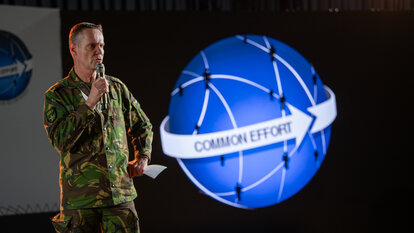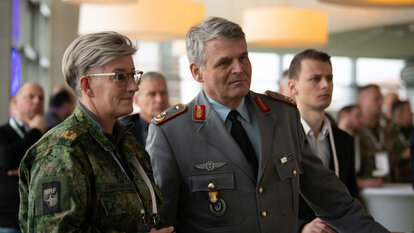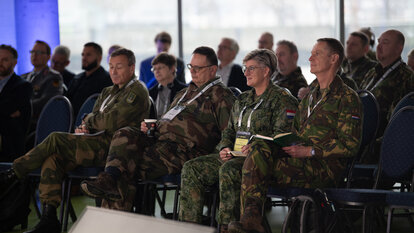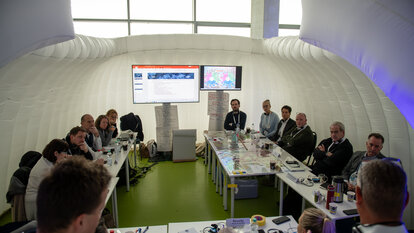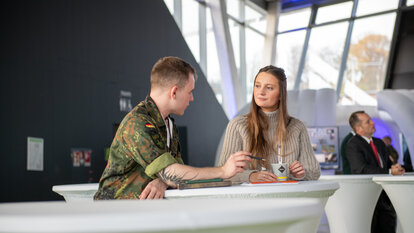Common Effort Convention
Know each other before you need each other! From societal resilience to readiness for war

"Know Each Other Before You Need Each Other" - Motto der diesjährigen Common Effort Convention zum Thema Resilienz, hybride Bedrohungen und kollektive Verteidigung.
© 1GNCThe Bundeswehr must become Kriegstüchtig, fit for war, according to German Defence Minister Boris Pistorius. Pistorius has been sparking discussions for weeks already with this choice of words, especially in Berlin. Kriegstüchtigis reiterated six times in the new Defence Policy Guidelines 2023: as the guiding principle for soldiers and as the description of the Bundeswehr of the Zeitenwende - as laid out by the ministry and emphasized by Pistorius at every opportunity. Criticism arose from within his party’s own ranks, from the Greens and the CDU-CSU faction. However, the Liberal FDP Party has welcomed this new direction, as Dr. Marie-Agnes Strack-Zimmermann, the chairwoman of the Defense Committee, commended the accuracy of the term and emphasised the necessity of honest and direct communication. Societally, this primarily means that, hopefully, it will stimulate the much-needed shift in mindset. Strong defence capabilities are necessary for a free and secure society and it is important to have an open conversation about this.
How can civil society, industry, and politics contribute to making Germany capable of defence and, indeed, warfare? One way is through extensive collaboration. In 2010, the 1st German-Netherland Corps established the Common Effort Community - a platform for civil-military cooperation, fostering mutual trust and encouraging joint efforts towards a common goal: fortifying resilience and ensuring comprehensive security. Initially designed to enhance the integrated approach in international crisis management, there is now an increased focus on this integrated approach in the context of Europe’s territorial defence. Recognizing the significance of Russia’s hostile aggression against Ukraine for all of Europe and NATO, a new pillar focusing on resilience, hybrid threats, deterrence, and collective defence, has been established within the work of Common Effort for the past two years.
Countering hybrid threats
A major issue at the moment is resilience against hybrid threats. In recent years, these threats have been a growing area of concern for liberal democracies worldwide. By using a mix of conventional and unconventional methods, by both state and non-state actors, they compromise security, undermine decision-making processes and destabilize democracies. This is done across domains in a way that is designed to remain below the threshold of detection and attribution. Recent examples include the use of cyberattacks, disinformation campaigns (COVID-19 conspiracy theories), electoral interference (Brexit, US elections in 2016 and 2020), the targeting of critical infrastructure (Like the hacker attack on the government network in 2018 or the sabotage of the Nord Stream 2 pipeline in 2022) and the instrumentalization of migrants (as seen in artificial migratory flows to Lithuania and Finland).
At the moment, European countries encounter hybrid attacks on a daily basis. This is increasingly recognized as a strategic threat that calls for a European response. However, this is far from easy. Hybrid actions are specifically designed to take place in grey areas where it is not clear who is responsible for what. Therefore, building up resilience against this not only requires cooperation between different European countries, but also between different sectors and the different actors within those domains.
To improve resilience, it is also important to get a better picture of the vulnerabilities. By identifying weak spots, countries can mitigate the risks and prepare for scenarios of an attack. This is especially relevant for critical infrastructure, such as communication systems, power grids and transportation networks. These services are crucial to maintaining vital societal functions and they are therefore a prime target for foreign adversaries.
Infrastructural resilience, attribution of attacks, and media and information literacy go hand in hand with another important aspect: societal resilience.
Societal Resilience - of civil defense and total defense
Critical for addressing and responding to such threats and attempts to destabilize our democracies is societal resilience. This requires adequate training in media literacy to contextualize narratives and uncover disinformation, as well as a strong awareness of one’s own and potentially adversarial interests. Ideally, a resilient society can absorb shocks and attacks, adapt, and recover without compromising fundamental values and structures. This also involves thoroughly examining scenarios – what are the aims of attempts to destabilize? How does the transition from below-the-threshold attacks escalate into a direct threat to security and potential military aggression?
There are still gaps in both the legal definition of terminologies and the political will to clearly identify attacks and aggressors in Germany. Particularly, urgent work is needed on the political attribution - Germany and Europe can learn from the Nordic Total Defence strategies in this regard. This strategy engages not just the military but also the entire society to ensure security. It means coordinating all sectors - civil society, economy, and politics - to identify and counter threats. An example is the exchange of knowledge, especially in the realm of disinformation and cybersecurity. However, it also means that civilian infrastructure can be used for military purposes without immediately causing societal uproar, as seen in Air Defender 2023: In June 2023, the largest deployment exercise of air forces since NATO’s inception took place with 250 aircraft from 25 nations and over 10,000 soldiers, led by Germany. Despite it being a significant signal for deterrence and a crucial exercise to strengthen European defense capability, German newspapers only focused on complaints about delays in civilian air traffic.
Another good example for strengthening societal resilience is Taiwan, where a Civil Defense Training was established through the initiative of non-governmental organizations to train civilian skills in population protection. The KUMA Academy, one of the largest population protection organizations in Taiwan, offers workshops for civilians. The aim is to educate civil society to actively participate in their own security and thus relieve the military in emergencies. Media literacy, location and communication without internet, first aid, seeking shelter are all part of these workshops.
Common Effort
Overall, the Bundeswehr and industry, science, and politics benefit greatly from more cross-sectoral exchange and a deeper mutual understanding. Peace and security researchers who have never engaged with the military lack a crucial perspective in their analysis. Politicians and government officials responsible for budgetary decisions or decisions relevant to foreign security and defence would profit from direct insights into the reality of the troops. Educational institutions also stand to gain by understanding the security aspect of the state. Soldiers would obtain a better overall picture of their mission when societal and political factors are directly communicated - fostering a natural path for mutual interaction and open discussion. The industry can make a significant contribution by sharing insights into protecting their infrastructure and connectivity, potentially enhancing collaboration with relevant scenario planners in the Bundeswehr.
All of this does not imply the securitization of society or the neglect of major challenges of our time such as combating climate change. On the contrary, we need to find a common language that fosters understanding and ensures that every segment of our society can contribute to freedom and security.
In short, we can only protect ourselves from attacks, by preparing for them together. Or, as the Romans already said: if you want peace, prepare for war.


